"Leave mushrooms on the counter until they turn into a black, inky mess, then puree this goop and eat it" sounds like instructions in a recipe for someone on a quest to make themselves sick. It's actually edible and tastes like mild mushrooms.

For the unfamiliar, Shaggies are part of a group of mushrooms called inky caps because the mushrooms quickly turn to a goopy black mess, (a process called deliquescing) which, in the past, was used to make a kind of ink.
Newsflash: you can eat the mushroom ink, and it's actually good. Good enough that I served it to two Mycological societies last year in Brainerd. So, before you toss any less than perfect ink caps out with the pencils shavings, you might consider a few possibilities.
Coprinus Comatus Only
As an aside here, know that I'm only using shaggy mane mushrooms (coprinus comatus) for this process, as using other Coprinoids could result in alcohol sickness as happens with Coprinopsis atramentaria, the tippler's bane.
I have to thank David Arora and Chad Hyatt here for mentioning the process in one of my favorite Facebook groups, without them, I would've never tried it. If you're not familiar, Chad's also the author of The Mushroom Hunters Kitchen, which he self-published a few years back.

If you've picked shaggy manes, you're probably familiar with their short shelf life--a day or two out of the ground and they can start to get inky, goey and soft on you.
It's counter intuitive to eat things "past prime" especially with wild mushrooms, but with shaggy manes I found it helpful to take look at what deliquescing is, and more importantly, what it does.

Deliquescing vs old, moldy, or past-prime mushrooms
From the journal of Wild Mushroom Hunting:
"Deliquescence is a process whereby the pileus liquifies itself to allow the spores to escape. The pileus starts liquifying itself at the margin, leaving the margin tattered and flaring (above the liquifying zone, the pileus is usually straight vertically). Often there is a reddish zone at the transition between the white immature gill tissue and the liquifying tissue which is black with the mature spores."
So, the deliquescing basically helps the mushrooms spread their spores, and in the process, returns the mushrooms from whence they came.
As I understand it, this should be an enzymatic reaction, basically the mushrooms way of speeding up the process of spreading their spores, as opposed to decomposition by nearby fungi, molds you wouldn't want to eat, etc.
Huitlacoche is another good example of deliquescing, and slightly similar in flavor, which I'll get to. Consuming deliquescing mushrooms, or at least the two species I mention here, is different than say, eating a moldy mushroom you found on the ground, or in your fridge the later being a good way to flirt with indigestion.

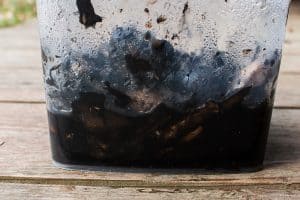
Some like them black
As I dug deeper over the past year, going over my tasting notes and comparing them with other hunters, more than one experienced shaggy mane eater told me they prefer to let their shaggys get a bit inky before cooking them, as they preferred the flavor.
Personally, I prefer my shaggy manes either or. I either want them firm, fresh and pristine, or completely gone "to max capacity" if that makes sense. Part of what I love about shaggies is their texture, and getting them inky means they're going to be a bit softer. Personal preference.
The Process
The basic process, stirring the mushrooms around and keeping them in the fridge over a six day period. Leaving the mushrooms to deliquesce at room temperature will speed up the process, where refrigeration will slow it.

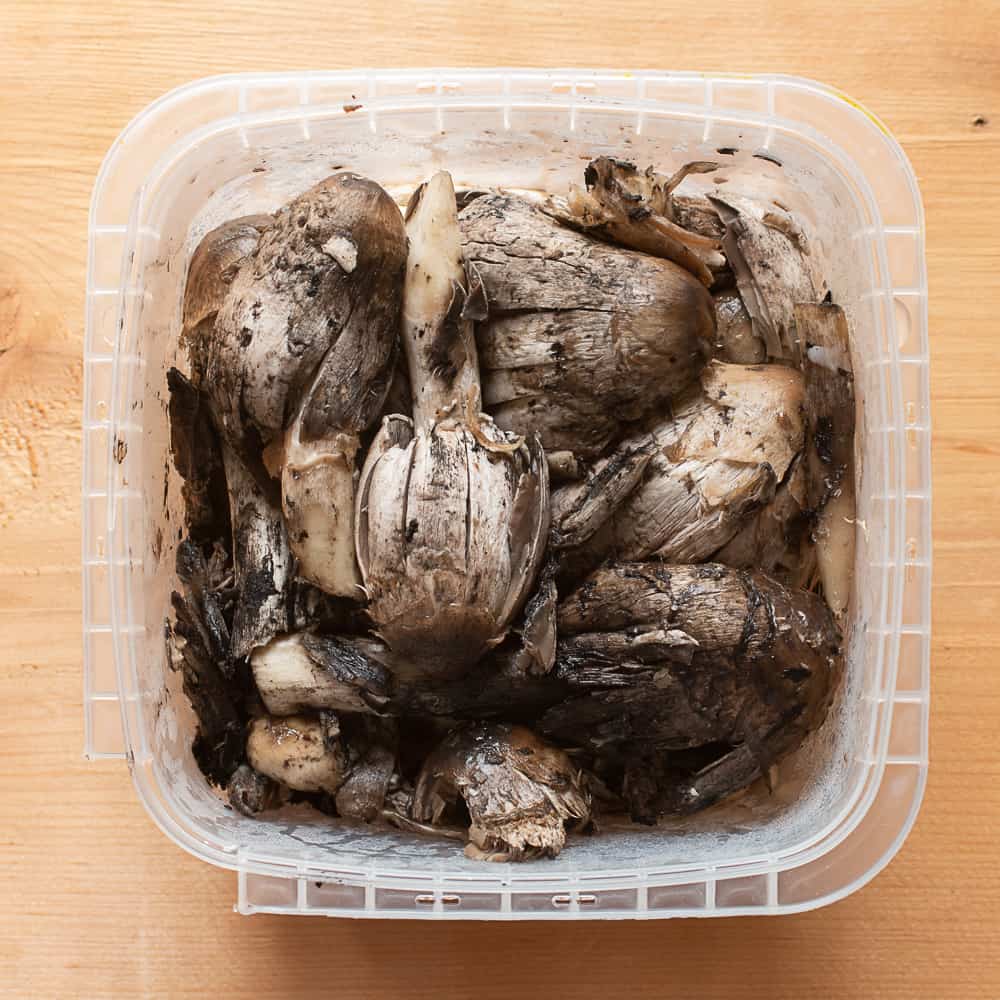




How does it taste?
The big question. Shaggy mane ink tastes mushroomy, like you might expect, but the flavor wasn't as deep or nuanced as I'd hoped, it's good, don't get me wrong, but I was expecting more of a deep umami blast.
It's mild and pleasant, similar to a puree made from common mushrooms like agarics, but with a noticeable difference I tasted right away. If I get lucky enough to grab another large flush of them, It might be fun to inoculate the goo with koji fungus for 24-48 hours to build some additional flavor, cooking and pureeing afterword.

It is worth it?
For me, it depends on the harvest. For example, If I came across a large quantity of shaggy manes, of varying ages (I just got a message a few weeks ago from someone with 20+lbs in Iowa!) like with other mushrooms, I'd separate out the most pristine ones for eating fresh. The mushrooms that don't make the cut could get made into ink and frozen to preserve them.
If I came across a patch of shaggy manes and they were all beautiful and young, none of them would be made into ink, If I find some at a stage too wet for me to eat fresh, they might all be ink. I would let the mushrooms and your preferences be your guide.


The Huitlacoche similarity
Shaggy mane ink has a very slight after taste to it, not unpleasant exactly, but present. If you've ever eaten huitlacoche, especially some that have gotten a bit soft or black, you'll be familiar with the taste. Some people call it metallic, tin-y or aluminum like, and, to be fair, that's not a bad comparison. I would say saffron can taste tin-y too.
At least with my ink the taste was barely noticeable, especially after pureeing with shallots, a splash of wine, and whisking in a healthy glob of butter. The big takeaway here I found interesting was the parallel flavor of two deliquescing mushrooms.
Huitlacoche and shaggy mane mushrooms are in two completely separate genus, and fruit differently, but it was interesting to notice the similarity in taste that I can only assume is a result of the deliquescing process.
Recipes and ideas for shaggy ink
The finished puree can be added lots of things, but, it's also black, and, in the wrong place can make an unappealing dish. Think of blank canvases of color here, or ways to use the puree where it's placed under the food, rather than tossed in, or spooned over the top.
Whisking with butter and spooning into a bowl before you add some freshly cooked pasta tossed with cooked greens, bacon and mushrooms would be nice, as is black shaggy risotto and compound butter. Creamy mushroom ink soup is a natural one, too, and would be great with chopped shaggies fried and spooned on top. So many things!
Pasta with shaggy ink sauce
Warm up the shaggy mane ink, swirling in some butter, then season to taste. Arrange dressed pasta on top. Pictured is herb and cheese ravioli with sochan greens tossed in a bit of olive oil.

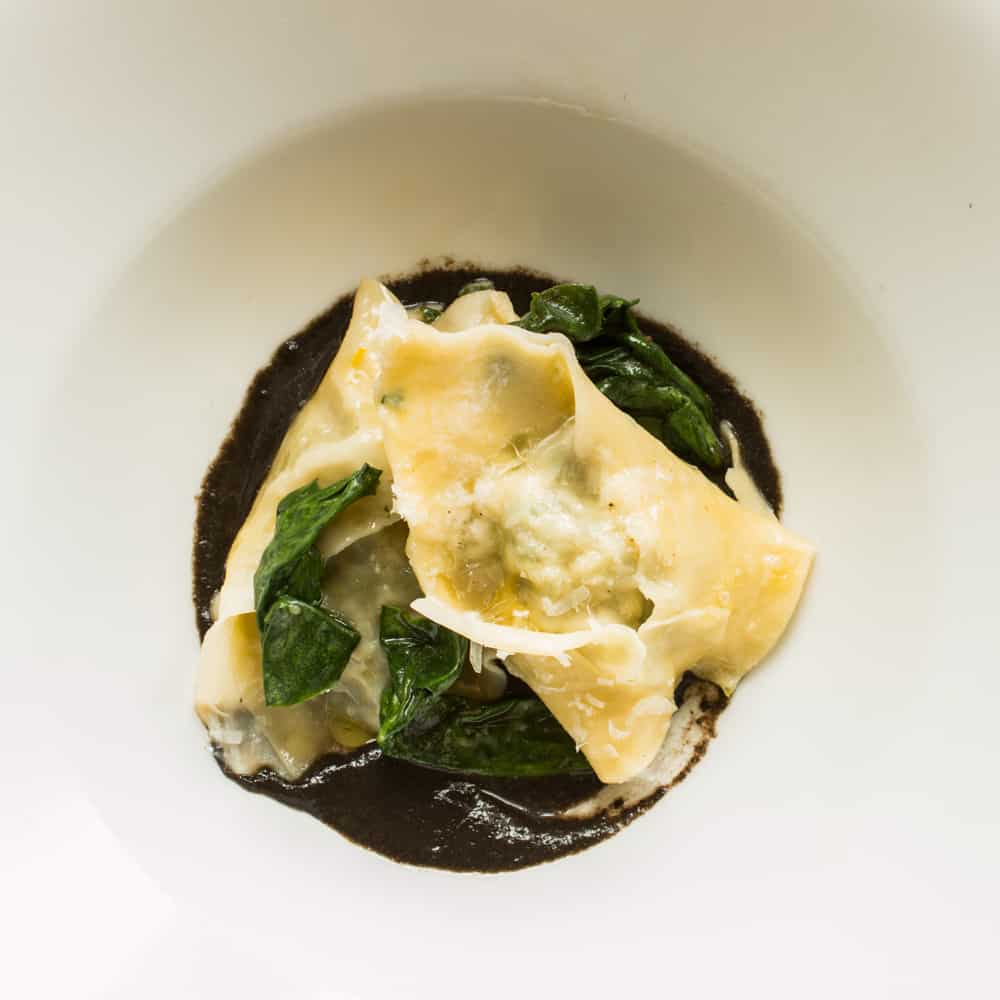
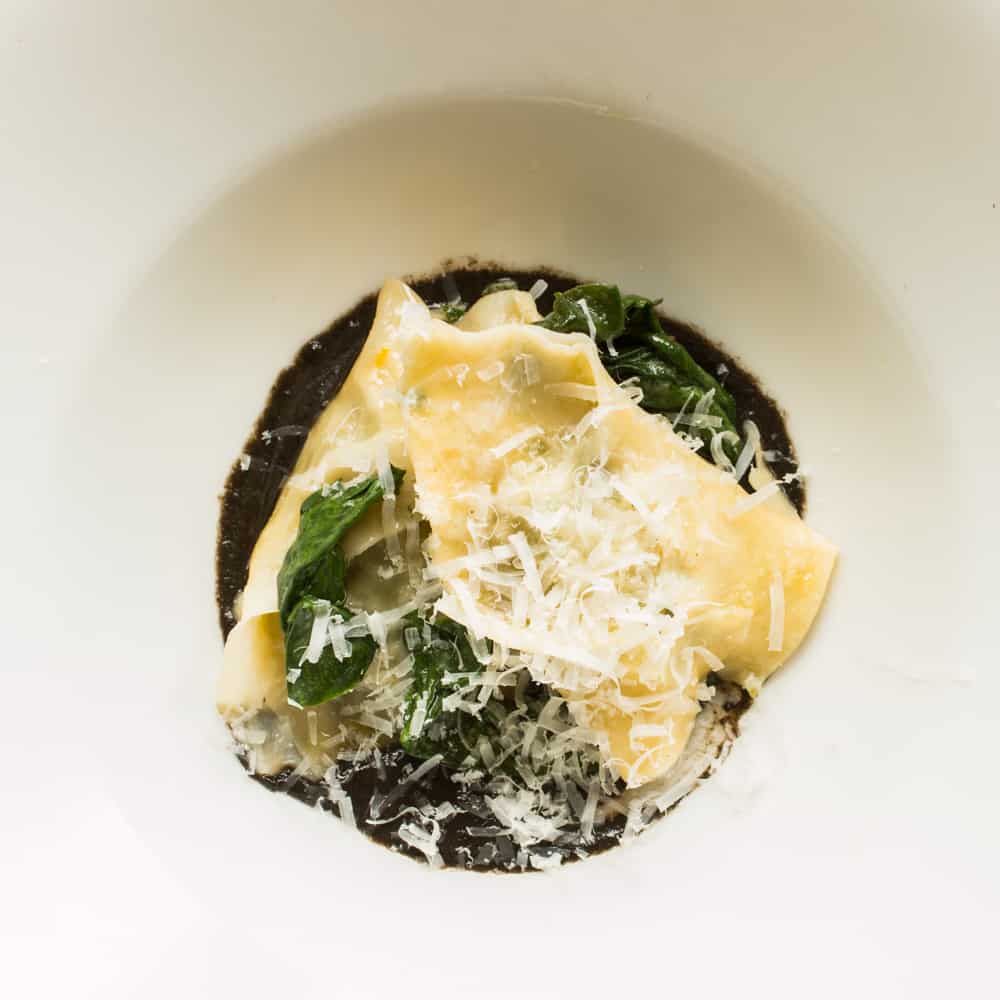
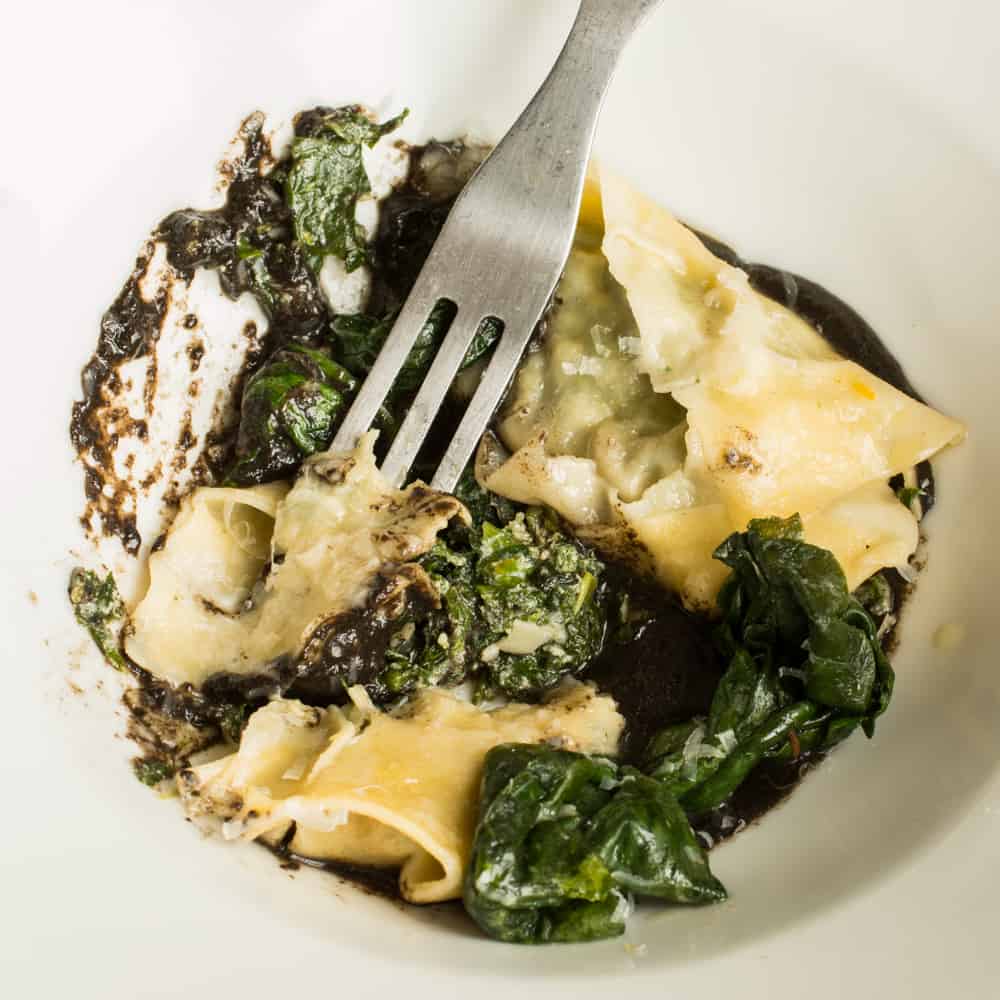
Shaggy Mane Ink
Ingredients
- 8 oz fresh shaggy manes
- ¼ teaspoon kosher salt
- ¼ cup chopped shallot 1 medium shallot
- 1 small clove garlic grated or minced
- 2 Tablespoons flavorless cooking oil plus more for sweating the shallots
- Splash of white wine
Instructions
- Clean the shaggy manes, rinsing or washing if needed, especially if they were growing in a sandy area. Allow the mushrooms to dry between two layers of paper towels for a few minutes to weep water. Chop the shaggy manes, then put into a non-reactive container like a mixing bowl. Cover the container loosely with cling film, cheesecloth, or a towel during the process.
- Store the mushrooms in the fridge at night, but take them out and allow them to sit at room temperature for a while each day to speed up the process. Allow the mushrooms to deliquesce and macerate in their own juices, stirring with a clean spoon at least once a day, until the mixture is juicy, inky, and black.
- The process will take a few days, longer if they’re refrigerated. When the mixture is black, goey, and scary looking to your liking, sweat the garlic and shallot in a small sauce pot for a few minutes until translucent.
- Add the splash of wine, then the shaggy mane goop, heat through and bring to a boil, then turn down the heat down to low and cook, covered, for 10 minutes.
- If the shaggy mane goop looks dry, add a little water.
- Using a handblender, puree the mixture, drizzling in the oil, adding a spoonful of water if needed to help the blades move.
- Transfer the shaggy mane puree to a container and refrigerate for up to a week, freeze, or make into compound butter and freeze for long term storage.
Notes
Black Shaggy Mane Risotto
Ingredients
- 1 cup risotto rice such as carnaroli
- ¼ cup shallot finely diced
- 1 cup black shaggy mane puree
- 4 cups hot chicken stock highest quality available
- ½ cup dry white wine
- ¼ teaspoon kosher salt plus more to taste
- 5 tablespoons unsalted butter at room temperature
- ½ cup grated high quality parmesan cheese like Grana Padano, at room temperature
- Toasted garlic slices to garnish (optional)
- ½ bunch fresh chopped Italian parsley about ½ cup
- 2 tablespoon olive oil or other cooking oil
- Garlic chips optional, for serving*
Instructions
- Sweat the onion in 2 tablespoons of the oil, then add the rice, stir to coat with oil, cook for a few minutes, then add and the hot stock, ½ cup at a time, stirring constantly.
- When you’re about halfway through adding the stock, add the shaggy mane puree. Continue stirring and adding stock until the rice is just done (you can also pre-cook the risotto as in my method here).
- Finally, stir in the butter, cheese, and parsley, then taste, adjust the seasoning as needed, and serve, topping each bowl with a few garlic chips if using and an additional sprinkle of parsley



Sandra Newbury
I found about 20 lbs of shaggy manes so I’ve been trying all your prep recipes! I set up several containers to make ink - two were open bowls and three were mason jars. I twisted the mason jars closed and in a couple days they seemed to be fermenting - fizzy liquid and smelled like ferment. The mushrooms had started to get inky but they seemed to stop as it fermented. What was in the open bowls came out incredibly delicious! I didn’t have wine but used a splash of bourbon. Should I have left the lids looser? I’d appreciate any thoughts!
Jessica Reiter
Is it possible to make this ink with common ink caps - Coprinopsis atramentaria? As long as I do not use/consume any alcohol?
Alan Bergo
Probably but I can't recommend that.
Paul Basel
I let mine deliquesce for 4 days… and it kind of smells like a dirty diaper… looks like black goop though. Is that normal?
Alan Bergo
Smell can be subjective. I would cook it and process, season and taste.
Antonio C
Hey, came across a huge patch of shaggy manes yesterday, cooked the younger ones confit in olive oil and the more mature one are deliquescing. What are your thoughts on salting these in hopes of potentiating lacto fermentation, or would it kill or damage the enzymes? Maybe best to let the mushrooms deliquesce, then purée and lacto that paste?
Alan Bergo
I haven't done lacto paste with them, if you do it I would only ferment the paste for a couple days as it could get bitter.
Crystal
These can kill you if consumed with alcohol!
Alan Bergo
No they won't and that's an old wives tale I'm tired of unpacking. Your comment is alarmist and there's absolutely, positively, nothing lethal in these mushrooms. What your referring to is a reaction with alcohol due to compounds found in SOME Coprinoid mushrooms, of which shaggy manes are one of many. What happens is people mis-identify other inky caps as shaggy manes, drink with them, get sick, and then tell all their friends it was the shaggy manes fault. For reference, the mushroom that is usually thought to cause this should be Coprinopsis atramentaria, and/or Coprinopsis variegata. It's not the mushrooms fault you get sick if you don't know to identify it.
VELMA STERENBERG
Alan, I just knew your website would be the place to find a use for the Coprinus comatus ink! I have beautiful goop from ca. 2lb of "discards" my foraging buddy refused to use and I refused to throw out. I was pondering how I could process it into a comestible that could be stored over time.
For future considerations, try this one. We must travel 3h one way to find Shaggies in quantity and last year, I couldn't bear to throw out those that were starting to deliquesce. So I made "black Coprinus comatus duxelles " and OMG, they were much more flavorful than the pristine white duxelles. I kept them simple, but think I included small amount of minced, caramelized red onion and either no alcohol, or a tiny splash of dry white vermouth.
Can be used in everything calling for duxelles, but you must warn the squeamish dinner guests that nothing poisonous is in their black soup, pasta sauce, risotto, stew, quiche or scrambled eggs, stuffed veg or flowers, to name a few. Make a couple different batches; some coarsely chopped and some fine, depending on how much texture you want in a given dish. Makes a good theme dish for Halloween.
So happy that I can process the ink and make compound butter. Bless you and thank you.
Carlin
Maybe if you cook the ink slowly even with a bit of sugar you could encourage a maylard style reaction and get a more umami flavour out of it. It would also be interesting if the same enzymes would deliquesce other unrelated mushrooms (since most mushrooms are made of chitin) after applying it on them to make a kind of sauce or broth.
Alan Bergo
I wouldn't put sugar in it. If you want a slow caramelization I'd add about 15-20% of the total weight in oil and cook it on low in a crock pot for 24 hours, might need some extra liquid too.
Garry Watson
I don't wait for the mushrooms to naturally deliquess. Rendering them through gentle simmering will also reduce them into a lovely ink/gravy/sauce base (If you want it to be smooth, run it through a blender or strain, as the stems take an inordinate amount of time to break down through cooking). With this base, I love to make a black garlic mushroom sauce, with butter, stock (if required), herbs and seasonings to taste.
Recently, I made such a garlic butter mushroom sauce from mica ink caps (also known as glistening ink caps), Cajun spice blend, Itqlian seasoning (herbs blend) and a stock cube, which was enjoyed as a pasta sauce, for penne, topped with crispy bacon pieces accompanied with a fine glass of red wine.
Enjoy playing with your food
Bushpirate
Carla Beaudet
Shaggy manes came up along our driveway two weeks ago, and my husband was the one who noticed them. There were quite a few, but most were already into the inky stage. I harvested the few that were still all white, par boiled them, cut them into 1/4" rings, and added them to some leftover miso/mallow leaf soup I'd made myself for lunch over the weekend. But as I tried to settle back in to work subjects (working-from-home), the thought occurred to me - why not use the inky mushrooms the way one would use squid ink - to color/flavor pasta, for instance? I wondered whether you'd explored that subject, and it sounds like you had, but had not yet posted here about it. I wondered whether Chad Hyatt, the fellow who gave the cooking lecture at Telluride this year, and whose book I purchased, had had that thought? Indeed, he had, and I found guidance for my efforts right there in his book, which I have not yet read cover to cover. I enthusiastically went out and harvested all the mushrooms in their inky glory into a pot, and let them continue to deliquesce overnight. In the morning, it looked a lot like your day 6, and I added a small pinch of salt and simmered over low heat until they were a soupy mess, reduced, puréed, and froze the inky purée for future culinary efforts.
Alan Bergo
Of course you'd tried it already! Using it to color pasta is a nice idea, but it won't taste like much unless you serve it with more puree as a sauce.
Mcrae anderson
Could it be used like Squid ink to make black pasta?
Alan Bergo
Yes, just don't expect it to taste like anything. Much better to serve the puree with pasta as a sauce.
LUZ LOPEZDEE
i am 76 years old residing in BC i forage shaggy mane by our roadside and patio backyard. i have to have much courage to try your recipes but who knows maybe a couple of seasons more. enjoy
luz